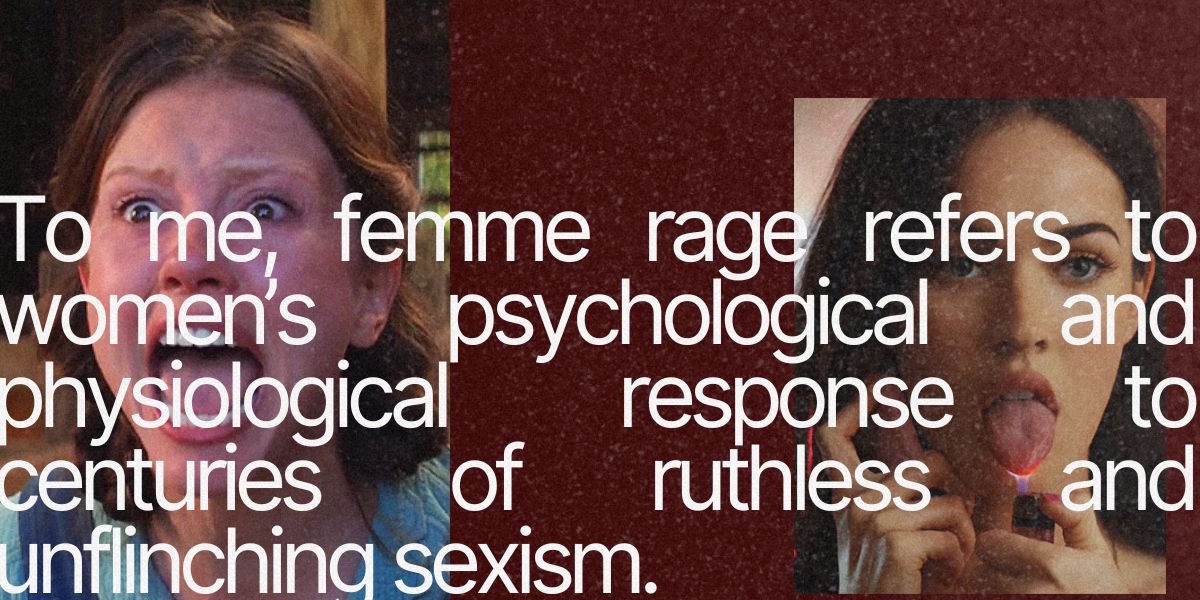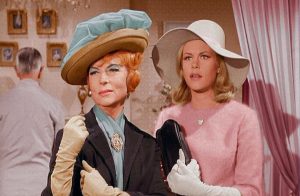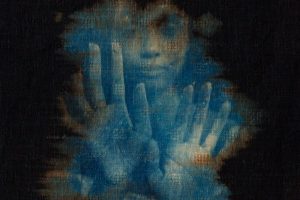Femme rage, hysteria and catharsis: Good for her
By: Marysia

When I was 12 years old, I read Charlotte Brontë’s Jane Eyre.
Strangely enough, what captivated me most wasn’t Jane’s fiery independence, or the beautiful gothic architecture of Thornfield Hall. It was Bertha Mason’s violent and distressing outbursts. Her “curious laugh; distinct, formal, mirthless” oddly filled me with a feminine pride I’d never before felt.
I later watched Franco Zeffirelli’s 1996 movie adaptation; seeing Bertha’s unflinchingly feminine fury was an even more cathartic experience.
The ‘mad woman in the attic’ trope – first coined by feminist literary critics Sandra Gilbert and Susan Gubar in their 1979 book The Madwoman in the Attic – suggests that feminine rage is a rejection of patriarchal society.
It is no wonder then that Bertha, arguably the first and most iconic ‘mad woman in the attic’, symbolised to me a freedom I had rarely seen in film and literature before.
Image credit: A24 / 20th Century Fox
In my short lifetime (I’m 18 years old), I have found myself both witnessing and experiencing instances of unrestricted ‘femme rage’.
To me, femme rage refers to women’s psychological and physiological response to centuries of ruthless and unflinching sexism. Often provoked by either aggressive or seemingly innocent encounters, it is a critical concept that allows us to distinguish between everyday anger and a psychosomatic reaction to the patriarchy.
This term is not strictly gendered, as femme rage can be experienced by anyone adversely impacted by misogyny and the patriarchy, however I’ll mainly be referring to women (trans and cis inclusive) experiencing it.
My femme rage has erupted in several ways, whether that be in response to a conservative adult’s disapproval of my ‘unladylike’ behaviour, or to downright harassment I’ve endured from grown men while walking down the street.
Although these moments have often left me miserable and confused, I believe that dissecting these experiences can help us better understand the malignant systems of oppression that seep into our relationships with one another.
Femme rage is far from new.
Until very recently, it was depicted as an unprovoked or unreasonable breakdown where a woman loses her sanity and recognisability, often leading to her death – either self-inflicted or imposed.
Eponymous characters in Henrik Ibsen’s Hedda Gabler (1891) and Daphne du Maurier’s Rebecca (1938) are perfect examples of texts where women are consumed by anger and resentment towards the men who have wronged them.
Hedda’s deep dissatisfaction with her marriage – a marriage she entered out of expectation, not love – makes her resentful and unhappy. Rebecca’s extensive sexual appetite and frivolous behaviours become too much for her conservative husband; she’s vehemently demonised by him and his new wife.
Hedda’s suicide and Rebecca’s murder perfectly illustrate the trope of femme rage being villified, rejected and ignored, then ultimately leading to the woman’s demise.
Throughout Western film, literature and art, women’s reactions to the patriarchy have been portrayed in a way that intends to provoke criticism and disgust.
Take the often misunderstood story of Medusa: punished for the violent actions of a man, her rage has since been weaponised to demonstrate how monstrous women can be.
Audiences, regardless of sex or gender, historically have been positioned to demonise and reject female characters such as Medusa, who spoke up – or rather, howled – about their discrimination.
These attitudes of course transferred into real life.
For centuries, women’s health concerns were often dismissed under the broad term ‘female hysteria’, a catch-all phrase that ignored the physical and focused purely on the psychological. ‘Hysterical’ women were shunned and isolated by their communities because of this conditioning.
In Medieval Europe, exorcisms were a standard tool utilised by the clergy to tackle this allegedly demonic affliction. In 1859, one-quarter of women in America were believed to be suffering from hysteria.
A study of US psychiatric institutions from 1949 to 1951 found that nearly 60 per cent of patients who received a lobotomy (a once-thought ‘magical cure’ for hysteria) were women, despite men making up majority of patients overall.
Crucially, hysteria was not seen as a malignant illness that forced itself upon women – it was believed to be something they were consciously responsible for acquiring. It wouldn’t be too far a stretch to argue that this ideology still remains in the medical field today, and in the subconscious of a startling number of individuals.
These beliefs manifest further in sexist and racist notions such as the ‘angry black woman’ stereotype.
In their 2017 research paper ‘Aggressive Encounters & White Fragility: Deconstructing the Trope of the Angry Black Woman’, Trina Jones and Kimberly Jade Norwood describe this stereotype as when black women’s anger is vilified and manipulated to “deflect attention from the (white) aggressor and to project blame onto the (black) target”.
Jones and Norwood discuss the psychological and material toll this trope has on black women in their everyday lives, as they weigh up the consequences of expressing frustration, then being deemed ‘threatening’ and made hyper-visible.
Interestingly, current cinematic depictions of femme rage happen almost exclusively within a horror context.
There is a tension that exists in horror: the liberating quality of portraying feminine anger, and the possibility that it may perpetuate traditionalist understandings of ‘hysterical’ behaviour. However, in recent times, horrific depictions of this rage have been primarily empowering.
These are typically brought about using the ‘good for her’ trope, where a woman’s revenge and retaliation is accepted and celebrated. This trope has been popularised by films such as Gone Girl, Midsommar, Pearl and Jennifer’s Body. They showcase an unconventional sense of vindication women feel after committing vile acts of vengeance.
Stephen King’s Carrie is one of the first widespread instances of this trope. Carrie’s violent acts of retribution, though morally questionable, are justified in the eyes of the audience because of the horrific treatment the young woman suffered at the hands of her peers and mother.
Texts utilising the ‘good for her’ trope establish a space where femme rage can exist, be legitimised, and then projected outwards.
We can’t ignore the fact, however, that majority of currently acclaimed representations of femme rage are white – perpetuating the harmful idea that some women’s anger is more acceptable than others.
It appears the only way society has allowed – or at the very least, tolerated – femme rage is when it is displayed by white, cisgender, conventionally attractive women, and portrayed through the aestheticised lens of film.
One recent show that disrupts this pattern is I May Destroy You, a critically-acclaimed and Emmy-winning series created and written by Michaela Coel. The series closely examines the intersectionality of race and gender, and how women can experience and work through rage in a way that is liberating, but ultimately not detrimental to themselves or others.
I know that I and many others regard Sylvia Plath’s Lady Lazarus as not only a gruellingly authentic poem on the trials of womanhood, but an example of audacious womanly wrath.
The aim now is to communicate to everyone the relief femme rage can provide us all, while also opening this trope up to women of colour.
It’s been almost six years since I first read Jane Eyre. In that time, I’ve come to understand Bertha on a much more personal level. Seeing beyond the ‘mad woman in the attic’, I’ve been able to understand how femme rage manifests itself in different contexts, and how the added intersectionality of race, class and age influence the way that passion is both expressed and received.
As I approach adulthood, my growing experiences of femme rage have continued to be both vindicating and exasperating.
In recent times, events such as Jo Koy’s deeply offensive Golden Globes speech have made my rage flare up, and rightfully so. But after the initial moments of disgust, horror and disappointment, I’ve learnt to turn to writing to better unpack my response.
In analysing those responses and discussing my thoughts with others, I can turn my femme rage into something both productive and manageable. It becomes something I can engage with and be liberated in, but not be consumed by.
By writing and sharing this piece, I hope to have achieved just that.
Marysia is a Year 12 high school student and emerging writer who lives on the Wajuk land of the Nyoongar nation. She has had her work published by a variety of publications and competitions, which include issues 19 and 22 of the VHS Tracking Zine and The Young Doctors Essay Competition. She primarily writes short stories and social commentary pieces, and is a diverse reader. She is passionate about gender issues as well as the climate crisis.













